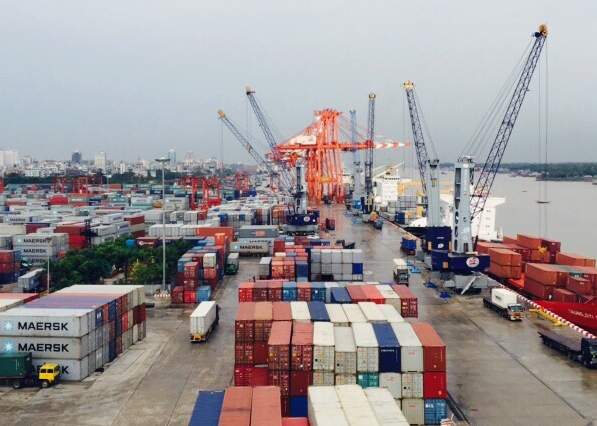Burma’s new government has been grappling with its first economic management crisis, as a weeks-long traffic jam of cargo ships at the country’s biggest port threatens to scare potential investors away and choke off nascent economic growth.
The bottleneck at the dilapidated port was caused by a spike in demand for goods as the opening up of the economy accelerates following a historic election win by Aung San Suu Kyi’s National League for Democracy (NLD) in November.
“Because of the general growth of the economy we are packed. The ships have nowhere to go,” said Ma Cherry Trivedi, managing director of Ayudroma International, an advisor to Myanmar Industrial Port (MIP), where congestion has been worst.
Burma boasts one of the world’s fastest growing economies, expanding at 7-8 percent in the years since the military relinquished direct control in 2011.
But its main port has changed little since the end of British colonial rule nearly 70 years ago — emblematic of ramshackle infrastructure that could hold back the foreign investment Suu Kyi needs to live up to sky-high expectations and remake a country impoverished by decades of junta rule.
The number of ships docking in Rangoon has doubled over the past decade and the number of containers has jumped fourfold, data shows, clogging up inadequate storage space, overwhelming sclerotic logistics systems and delaying deliveries.
“We bring in the steel, the cement, everything you can think of,” said Ma Cherry Trivedi. “As infrastructure grows, which is the key aspect of any development in a country like Myanmar, you are going to see massive growth in imports.”
Western shipping lines are largely confined to a single creaking terminal within the port, because of reluctance to use other facilities operated by Asia World, whose majority owner Steven Law remains subject to US sanctions.
Working 24/7
The tipping point into a crisis came when MIP miscalculated the volume of incoming shipments before a three-week holiday in April, when the country largely shut down, shipping companies operating at the terminal said. That meant up to 10 ships faced delays of as long as two weeks to have their cargo unloaded, causing the biggest jam the port had seen in modern times.
Industry sources said the hold-up cost major shipping lines millions of dollars a week.
“There was no proper cooperation between shipping lines, container storage facilities and terminal operators. Chaos,” said Aye Lwin, joint secretary-general of Burma’s Chamber of Commerce, who was involved in efforts to resolve the jam.
Burma’s presidential office announced emergency measures in mid-May to tackle the congestion, including 24-hour port operation and customs clearance, and ordered daily reports from the ministers of commerce and transport.
[related]
Some of the biggest shipping companies, such as Denmark’s Maersk Line Ltd, dispatched their own specialists to help manage the situation.
By Thursday, the backlog had been largely cleared, Ma Cherry Trivedi said, although additional staff flown in by shipping lines remained in place, as did the emergency measures, to prevent cargoes piling up once more.
Tatsuya “Ricky” Ueki, managing director at shipping company MOL Myanmar, said the port infrastructure has not caught up with the economic development of the country.
“There’s no easy way out of this, but billions of dollars in the country’s development hinge on how aggressive the government is in solving the problem,” said Ueki.
The port jam underscores the challenges Suu Kyi’s government faces to keep growth going and attract investment to a country struggling to compete with neighbours in sectors such as garment exports, which rely on accurate and timely deliveries.
“Lead times are very important,” said Jacob Clere, who works on a European Union-funded project to improve Burma’s garment industry.
“Taking a few days longer than those in the region, they [garment brands] will avoid Myanmar until the lead time is shortened.”
Not so sweet
Another factor contributing to the port disruption has been a crackdown by China on sugar smuggling, officials said.
Up to 1 million tonnes of sugar is trafficked into China every year, experts say, mostly entering the country from India and Thailand via Burma.
In March, just before the handover of power, Burma’s outgoing government issued additional “re-exporting licences” to sugar traders, Aye Lwin of the chamber of commerce said.
That meant that, just as port operations were closing down for the long April holiday, “four vessels came and discharged about 20,000 or 30,000 containers,” said Aye Lwin. “These containers couldn’t move for the time being, they were blocked.”
As China stepped up inspections, he said, “our cargo got stuck on the border. So a lot of containers cannot move and a traffic jam is formed all the way to the jetty in Yangon.”
“There should be quotas and some predictability,” Aye Lwin added. “Our governments should talk about it. Otherwise, it’s a total mess.”



